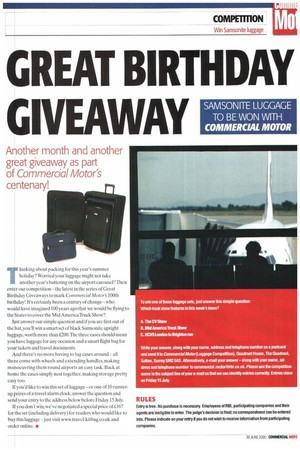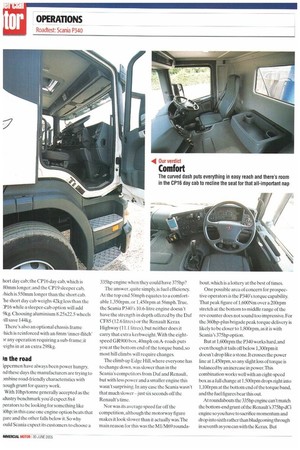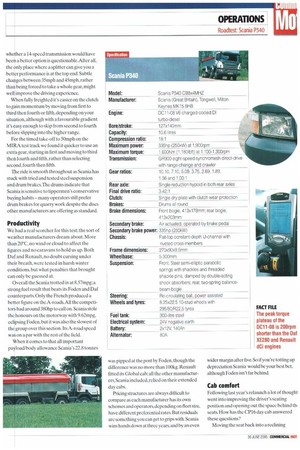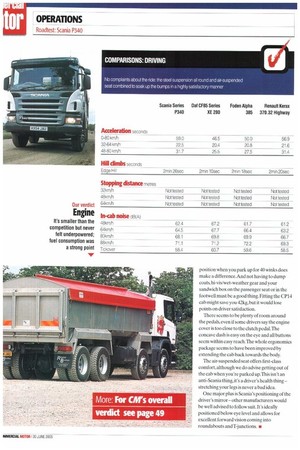GREAT BIRTHDAY
Page 43

Page 46

Page 47

Page 48

If you've noticed an error in this article please click here to report it so we can fix it.
GIVEAWAY SAMSON ITE LUGGAGE COMMERCIAL MOTOR TO BE WON WITH
Another month and another great giveaway as park of Commercial Motor's centenary!
Thinking about packing for this year's summer holiday? Worried your luggage might not take another year's battering on the airport carousel? Then enter our competition—the latest in the series of Great Birthday Giveaways to mark Commercial Motor's 100th birthday! It's certainly been a century of change — who would have imagined 100 years ago that we would be flying to the States to cover the Mid America Truck Show?
Just answer our simple question and if you are first out of the hat, you'll win a smart set of black Samsonite upright luggage, worth more than £200.The three cases should mean you have luggage for any occasion and a smart flight bag for your tickets and travel documents.
And there's no more having to lug cases around—all three come with wheels and extending handles, making manoeuvring them round airports an easy task. Back at home the cases simply nest together, making storage pretty easy too.
If you'd like to win this set of luggage— or one of 10 runnerup prizes of a travel alarm clock, answer the question and send your entry to the address below before Friday 15 July.
If you don't win, we've negotiated a special price of £167 for the set (including delivery) for readers who would like to buy this luggage —just visit www.travel-kitbag.co.uk and order online. u hort day cab; the CP16 day cab, which is 80mm longer; and the CP19 sleeper cab, ihich is 550mm longer than the short cab. 'he short day cab weighs 42kg less than the 1316 while a sleeper-cab option will add 9kg. Choosing aluminium 8.25x22.5 wheels /ill save 144kg.
There's also an optional chassis frame thich is reinforced with an 8mm 'inner-flitch' lr any operation requiring a sub-frame; it Tighs in at an extra 298kg.
In the road ippermen have always been power hungry, ad these days the manufacturers are trying to Jmbine road-friendly characteristics with nough grunt for quarry work.
With 10hp/tonne generally accepted as the tdustry benchmark you'd expect 8x4 perators to be looking for something like 50hp; in this case one engine option beats that gure and the other falls below it. So why ould Scania expect its customers to choose a 335hp engine when they could have 375hp?
The answer, quite simply, is fuel efficiency. At the top end 50mph equates to a comfortable 1,350rpm, or 1,450rpm at 56mph.Truc. the Scania P340's 10.6-litre engine doesn't have the strength in depth offered by the Daf CF85 (12.6 litres) or the Renault Kerax Highway (11.1 litres), but neither does it carry that extra kerbweight. With the eightspeed GR900 box. 40mph on A-roads puts you at the bottom end of the torque band,so most hill climbs will require changes.
The climb up Edge Hill, where everyone has to change down, was slower than in the Scania's competitors from Daf and Renault. but with less power and a smaller engine this wasn't surprising. In any ease the Scania wasn't that much slower— just six seconds off the Renault's time.
Nor was its average speed far off the competition, although the motorway figure makes it look slower than it actually was.The main reason for this was the M1/M69 rounda bout, which is a lottery at the best of times.
One possible area of concern for prospective operators is the P340's torque capability. That peak figure of 1,600Nm over a 200rpm stretch at the bottom to middle range of the rev counter does not sound too impressive. For the 360hp-plus brigade peak torque delivery is likely to be closer to 1,80Orpm, as it is with Scania's 375hp option.
But at 1,600rpm the P340 works hard, and even though it tails off below 1,300rpm it doesn't drop like a stone. It crosses the power line at 1,45Orpm,so any slight loss of torque is balanced by an increase in power.This combination works well with an eight-speed box as a full change at 1500rpm drops right into 1,100rpm at the bottom end of the torque band, and the fuel figures bear this out.
At roundabouts the 335hp engine can't match the bottom-end grunt of the Renault's 375hp dCi engine so you have to sacrifice momentum and drop into sixth rather than bludgeoning through in seventh as you can with the Kerax. But whether a 14-speed transmission would have been a better option is questionable. After all, the only place where a splitter can give you a better performance is at the top end. Subtle changes between 35mph and 45mph, rather than being forced to take a whole gear, might well improve the driving experience.
When fully freighted it's easier on the clutch to gain momentum by moving from first to third then fourth or fifth, depending on your situation, although with a favourable gradient it's easy enough to skip from second to fourth before slipping into the higher range.
For the timed take-off to 50mph on the MIRA test track we found it quicker to use an extra gear, starting in first and moving to third then fourth and fifth. rather than selecting second, fourth then fifth.
The ride is smooth throughout as Scania has stuck with tried and tested steel suspension and drum brakes.The drums indicate that Scania is sensitive to tippermen's conservative buying habits — many operators still prefer drum brakes for quarry work despite the discs other manufacturers are offering as standard.
Productivity
We had a real scorcher for this test; the sort of weather manufacturers dream about. More than 20°C, no wind or cloud to affect the figures and no caravans to hold us up. Both Pat and Renault, no doubt cursing under their breath, were tested in harsh winter conditions, but what penalties that brought can only be guessed at.
Overall the Scania trotted in at 8.57mpg; a strong fuel result that beats its Foden and Daf counterparts. Only the French produced a better figure on the A-roads.All the competitors had around 380hp to call on. Scania stole the honours on the motorway with 9.62mpg, eclipsing Foden, but it was also the slowest of the group over this section. Its A-road speed was on a par with the rest of the field.
When it comes to that all important payload/body allowance Scania's 22.8 tonnes was pipped at the post by Foden, though the difference was no more than 100kg. Renault fitted its Global cab; all the other manufacturers, Scania included,relied on their extended day cabs.
Pricing structures are always difficult to compare as each manufacturer has its own schemes and operators, depending on fleet size, have different preferential rates. But residuals are something you can get to grips with. Scania wins hands down at three years, and by an even wider margin after five. So if you're totting up depreciation Scania would be your best bet, although Foden isn't far behind.
Cab comfort
Following last year's relaunch a lot of thought went into improving the driver's seating position and opening out the space behind th. seats. How has the CP16 day cab answered these questions?
Moving the seat back into a reclining position when you park up for 40 winks does make a difference.And not having to dump coats, hi-vis/wet-weather gear and your sandwich box on the passenger seat or in the footwell must be a good thing. Fitting the CP14 cab might save you 42kg,but it would lose points on driver satisfaction.
There seems to be plenty of room around the pedals, even if some drivers say the engine cover is too close to the clutch pedal.The concave dash is easy on the eye and all buttons seem within easy reach.The whole ergonomics package seems to have been improved by extending the cab back towards the body.
The air-suspended seat offers first-class comfort, although we do advise getting out of the cab when you're parked up.This isn't an anti-Scania thing, it's a driver's health thingstretching your legs is never a bad idea.
One major plus is Scania's positioning of the driver's mirror other manufacturers would be well advised to follow suit. It's ideally positioned below eye level and allows for excellent forward vision coming into roundabouts and T-junctions. •


































































































































































































